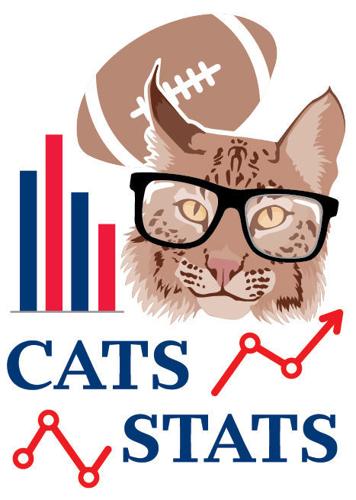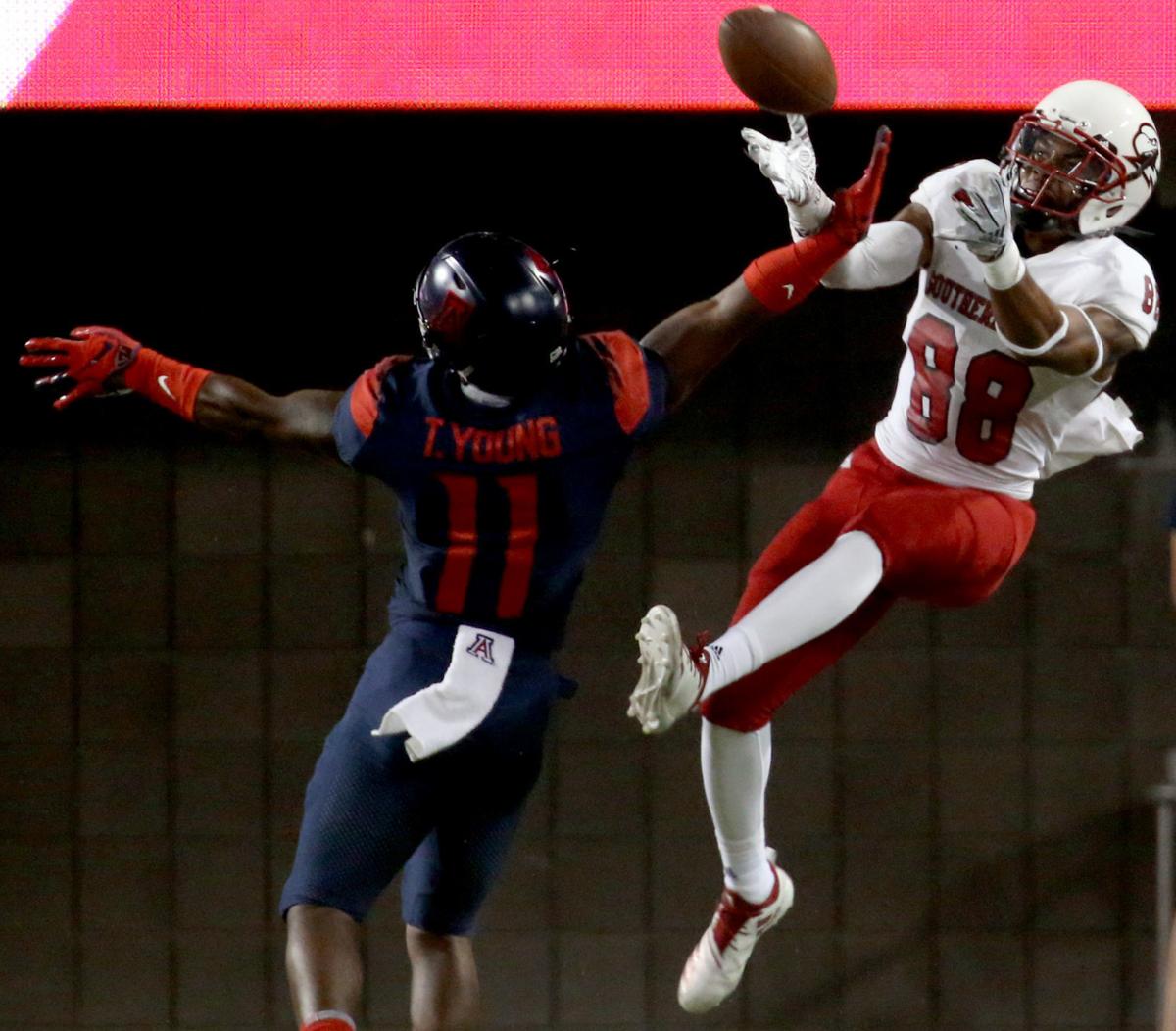Each week throughout the football season, we’ll take an in-depth look at the Arizona Wildcats from a statistical perspective. Here’s the latest edition of “Cats Stats.”
Arizona linebacker Tony Fields II has no interest in adopting the turnover prop gimmick that started with the Miami Hurricanes’ “Turnover Chain” and has spread across college football.
“I wouldn’t want to do it,” Fields said. “That’s more following another team. I’d rather just have us hype each other up.”
So no “Turnover Chainsaw” like the one Oregon State has?
“Come on,” Fields said.
Which isn’t to say Fields is uninterested in turnovers themselves. On the contrary: He and his teammates are desperate to produce more.

Editor’s note
Each week throughout the football season, we’ll take an in-depth look at the Arizona Wildcats from a statistical perspective.
Arizona, which hosts USC on Saturday, has only one takeaway in four games. The Wildcats are one of five FBS teams with just one. It’s a ridiculously low total, even by recent UA standards.
The 2016 Wildcats, who finished 3-9, had 14 takeaways in 12 games — an average of 1.17 per game that was considered substandard. Last year, Arizona averaged 1.79 turnovers per game. This year, the figure is 0.25.
Today we’re going to examine the impact that takeaways, or a lack thereof, have on winning percentage. We’re also going to explore whether the Wildcats’ dearth of turnovers is simply a product of bad luck that will even out over the course of the season.
Arizona has played 29 games since the start of the 2016 campaign, when Marcel Yates became defensive coordinator. The Wildcats have produced zero takeaways nine times, one takeaway nine times and two or more 11 times.
Arizona is 2-7 when it has zero takeaways; 2-7 when it has one; and 8-3 when it has two or more.
One of the wins in the zero-takeaway games came last week at Oregon State. The Wildcats outgained the Beavers 594-238 in a 35-14 romp.
The other was last year’s game against Colorado, when Khalil Tate came off the bench to rush for a record 327 yards. He also completed 12 of 13 pass attempts. It wasn’t a normal night in any way.
The two games Arizona has won since 2016 when producing one turnover came last year against OSU, when the UA rushed for a school-record 534 yards; and this year vs. Southern Utah, an FCS program.
The tree times Arizona has lost when forcing two or more turnovers came last season, including twice in the first four weeks. Arizona had two takeaways vs. Houston, but they were offset by two giveaways. The UA took the ball away twice against Utah but gave it away five times.
The only time since 2016 that the Wildcats have had two or more takeaways, a positive turnover margin and lost came in last year’s Arizona State game. But the Sun Devils blocked a UA punt, which doesn’t count as a turnover but has the same effect; It led directly to a touchdown. Arizona also had a punt-return TD overturned on a shaky penalty call.

Arizona has one takeaway in four games. Here, cornerback Lorenzo Burns picks up a pass interference penalty against Southern Utah.
It’s no secret that turnover margin correlates to winning percentage; it might be the most reliable statistic in football. In 2015, FootballScoop.com examined the previous seven seasons and found that 52 of 53 teams that posted a per-game turnover margin of 1.01 or greater recorded winning seasons.
It’s no wonder, then, that Yates constantly harps on the importance of takeaways.
“The linebackers, he reminds us every day,” Fields said. “The defense, he says it at least five times at practice. We need three takeaways every practice or we get in trouble. We’re trying to work on that more and more.”
Whatever Arizona has done so far hasn’t worked. Are the Wildcats doing something wrong? Do they lack the talent or schemes needed to produce turnovers? Or are they in the midst of an unlucky streak?
UA opponents have fumbled five times. The Wildcats have zero fumble recoveries. Virtually every statistical study suggests that recovering fumbles is roughly a 50/50 proposition. This is what ESPN.com NFL analyst Bill Barnwell wrote about that subject in November 2016:
“Forcing fumbles is a skill, and giving away fumbles is a legitimate liability. What happens once the ball hits the ground is mostly randomness. No team has exhibited a steady ability to recover a disproportionately high percentage of the fumbles in their games. Not even that team you know who runs fumble recovery drills in practice and makes it a priority. (All teams do that.)”
NFL defenses recovered 42.9 percent of fumbles in 2017, according to Chase Stuart of Football Perspective. By that math, Arizona should have two fumble recoveries this year. (It should be noted that a fumble the Wildcats recovered against the Beavers last week was wiped out when a replay review determined that the fumbler, quarterback Conor Blount, was down by contact.)
Oregon State officially fumbled three times on Saturday. UA coach Kevin Sumlin didn’t seem to think luck had much to do with Arizona not recovering any of them.“If we force something like that,” Sumlin said, “we’ve got to get on the ball.”
Said Fields: “We’ve just got to swarm to the ball a little bit more. Once we get the ball out, everybody’s gotta swarm. We can’t just have people that are in the area. We’ve gotta have guys that are 20 yards away. You don’t know where the ball’s gonna bounce when it comes out.”
Arizona’s lone takeaway this season came via an interception. The Wildcats are lagging there as well based on the number of passes they’ve broken up.
Bill Connelly of SB Nation’s Football Study Hall determined a few years back that about 22 percent of passes defensed should be intercepted. Passes defensed are interceptions plus breakups.
Arizona has 19 breakups this season. Based on Connelly’s research, the Wildcats should have at least four picks.
Last year, Arizona intercepted 27.9 percent of the passes it defensed. In 2016, that figure was 15.4 percent. This year’s 5 percent rate feels like an anomaly. Of course, things could be worse: USC has 29 pass breakups and no picks.
Interceptions are more about skill than luck. Defenders need to be in the right position, and they need to catch the ball. Pass-rush pressure helps too.
Fields is hopeful that he and his teammates can harass and confuse Trojans quarterback JT Daniels, an 18-year-old true freshman. Daniels has thrown three picks and fumbled twice in four games.
“I was once in that situation,” Fields said. “I know how he’s feeling. And he’s the quarterback.”
If the Wildcats can’t take the ball away — whether by skill, hustle, scheme or luck — they probably won’t win.







